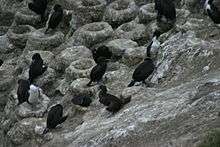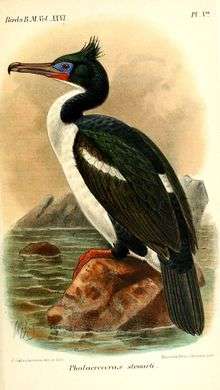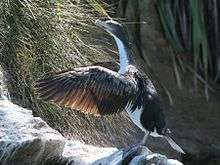Stewart shag
| Stewart shag | |
|---|---|
 | |
| Scientific classification | |
| Kingdom: | Animalia |
| Phylum: | Chordata |
| Class: | Aves |
| Order: | Suliformes |
| Family: | Phalacrocoracidae |
| Genus: | Leucocarbo |
| Species: | L. chalconotus |
| Binomial name | |
| Leucocarbo chalconotus Gray, 1845 | |
| Synonyms | |
|
Phalacrocorax chalconotus | |
The Stewart shag (Leucocarbo chalconotus), also known as the bronze shag or Stewart Island shag, is a species of shag endemic to the southernmost parts of the South Island of New Zealand, from the Otago Peninsula south to the Foveaux Strait, and to Stewart Island/Rakiura, from which it takes its name.
Some taxonomists (including the IOC) split this species into the Otago shag and the Foveaux shag, while others have kept them as conspecific. The International Ornithologists' Union also place this species in the genus Leucocarbo. Others place it in the genus Phalacrocorax.

The species is dimorphic in appearance. Roughly half the individuals are mostly dark bronze, but with white patches, similar to the king shag; the remainder are bronze all over. The two morphs breed together indifferently. These large, chunky birds are 68 cm (27 in) and weigh 1.8-2.9 kg (4-6.4 lbs).
Stewart shags breed colonially, making raised cup nests out of organic material and guano. Colonies are large enough to be strikingly visible, and are used year after year; there is a notable one on the northern shore of Taiaroa Head at the mouth of Otago Harbour. They feed in coastal waters, and are rarely if ever being seen inland or far out to sea.
They are related to the other blue-eyed shags.

References
- ↑ BirdLife International (2012). "Phalacrocorax chalconotus". IUCN Red List of Threatened Species. Version 2013.2. International Union for Conservation of Nature. Retrieved 26 November 2013.
External links
- Species factsheet - BirdLife International
